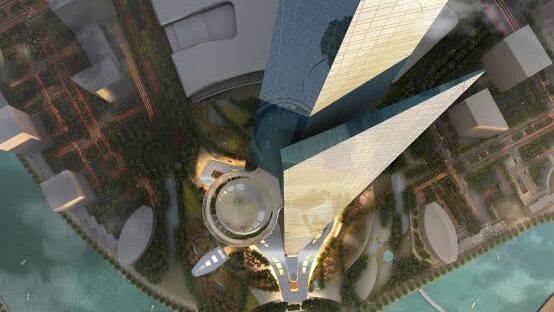Jeddah Tower, often referred to as the “Kingdom Tower,” is a groundbreaking architectural project that aims to redefine the limits of vertical construction. Located in Jeddah, Saudi Arabia, this ambitious project symbolizes the country’s aspiration to lead in innovation and economic transformation, as part of its Vision 2030 agenda. Designed to soar over 1,000 meters into the sky, Jeddah Tower is set to become the tallest building in the world upon completion, surpassing Dubai’s Burj Khalifa. Let’s delve into the story behind this monumental structure, exploring its vision, design, construction, and anticipated impact.
The Vision Behind Jeddah Tower
Jeddah Tower represents more than just a record-breaking skyscraper; it embodies Saudi Arabia’s ambitions to position itself as a global hub for business, tourism, and culture. Spearheaded by Prince Al-Waleed bin Talal’s Kingdom Holding Company, the project aims to enhance Jeddah’s urban skyline and attract investments to the region. Situated in the heart of the $20 billion Jeddah Economic City development, the tower serves as a beacon for the city’s transformation into a modern metropolis.
The project aligns closely with Vision 2030, Saudi Arabia’s strategic roadmap to diversify its economy and reduce dependency on oil revenues. By creating a landmark of global significance, the Kingdom seeks to boost tourism and elevate its standing on the world stage.

Design and Architecture
Jeddah Tower’s design is the brainchild of Adrian Smith, the same architect responsible for the iconic Burj Khalifa. Envisioned as a harmonious blend of modern aesthetics and cultural heritage, the tower’s design draws inspiration from the folded fronds of a desert plant, symbolizing growth and resilience.
The building’s triangular footprint and tapered shape are not just visually striking but also functionally effective. This aerodynamic structure minimizes wind resistance and enhances stability, a crucial feature for a building of this magnitude. The tower will feature over 200 floors, with more than 160 usable levels, and will include residential apartments, office spaces, luxury hotels, and observation decks.
One of the most anticipated highlights is the observation deck, which will be located over 600 meters above ground. This will be the highest publicly accessible vantage point in the world, offering breathtaking views of Jeddah and the surrounding Red Sea.
Engineering Marvels and Challenges
Building a structure that exceeds 1,000 meters in height is no small feat. The engineering team faced numerous challenges, ranging from structural stability to resource allocation. Here are some of the key innovations and strategies employed:
- Foundation and Stability
The tower’s foundation is an engineering masterpiece in itself. It consists of deep piles driven into the ground, capable of supporting the immense weight of the building. The foundation is designed to withstand the region’s seismic activity and harsh environmental conditions, including high temperatures and corrosive salty winds from the Red Sea. - Materials and Construction
High-strength concrete and advanced steel reinforcements are being used to ensure the building’s durability. The construction employs innovative techniques to optimize material usage while maintaining structural integrity. - Elevator Systems
Jeddah Tower will feature some of the fastest and most advanced elevators in the world, capable of traveling at speeds of up to 10 meters per second. Specially designed to handle the immense height, these elevators will ensure efficient vertical transportation for residents and visitors. - Sustainability Features
Sustainability is a core aspect of Jeddah Tower’s design. The building incorporates energy-efficient systems, including advanced cooling technologies and reflective glass to reduce heat absorption. Additionally, the tower aims to harness renewable energy sources wherever possible.
Construction Progress and Timeline
Construction of Jeddah Tower began in 2013, with the goal of completing the project by the mid-2020s. However, the project has faced several delays due to funding issues, logistical challenges, and broader economic fluctuations. Despite these setbacks, the commitment to completing the tower remains steadfast.
As of now, significant progress has been made, with the core structure rising steadily. Once completed, the tower will not only redefine architectural benchmarks but also symbolize perseverance and ambition.
Economic and Social Impact
The completion of Jeddah Tower is expected to have a transformative impact on both the local and national economy. Here are some of the anticipated benefits:
- Boosting Tourism
As the tallest building in the world, Jeddah Tower is poised to become a major tourist attraction, drawing millions of visitors annually. This influx of tourists will benefit local businesses, hospitality sectors, and cultural institutions. - Job Creation
The project has already created thousands of jobs during its construction phase. Upon completion, the tower and the surrounding Jeddah Economic City are expected to generate long-term employment opportunities in various sectors, including real estate, retail, and tourism. - Increased Investments
Jeddah Tower’s iconic status is likely to attract international investors, boosting confidence in the Saudi real estate market. This, in turn, will stimulate economic growth and diversification. - Cultural Significance
Beyond its economic impact, Jeddah Tower represents a cultural milestone for Saudi Arabia, showcasing the country’s ability to achieve feats of global significance. The tower’s design and functionality reflect a harmonious blend of tradition and modernity, making it a source of national pride.
Global Comparisons and Legacy
Jeddah Tower’s ambition to become the world’s tallest building places it in direct comparison with other iconic skyscrapers, such as Burj Khalifa and Shanghai Tower. However, its significance goes beyond mere height. Unlike many other tall buildings, Jeddah Tower is part of a larger urban development plan, aimed at creating a self-sustaining economic ecosystem.
The tower’s completion will set new standards in engineering, architecture, and urban planning. Its legacy is expected to inspire future projects, pushing the boundaries of what is possible in vertical construction.
Challenges and Criticisms
While Jeddah Tower is undeniably a marvel, it has faced criticism and skepticism over its feasibility and priorities. Some critics argue that the resources allocated to the tower could be better utilized for social infrastructure and community development. Others question the practicality of maintaining such a massive structure in the long run.
Nonetheless, proponents of the project emphasize its symbolic and economic value, highlighting its potential to drive innovation and global recognition for Saudi Arabia.
Conclusion: A Monument to Ambition
Jeddah Tower stands as a testament to human ingenuity and ambition. It encapsulates Saudi Arabia’s vision for the future, blending architectural excellence with economic aspirations. While challenges remain, the tower’s eventual completion will mark a new era in skyscraper construction and urban development.
For the residents of Jeddah and visitors from around the world, Jeddah Tower will not just be a building; it will be a symbol of progress, resilience, and boundless possibility. As the world awaits the final realization of this architectural masterpiece, one thing is certain: Jeddah Tower will leave an indelible mark on history.
Do follow Uae stories for more Updates
Unlocking the World of Discounts with Esaad Card: A Guide to Exclusive Savings













